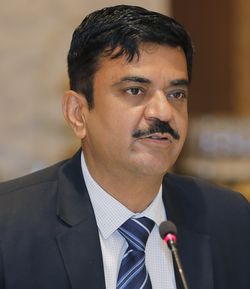Several world leaders, including Prime Minister Narendra Modi and his British counterpart Boris Johnson, recently came together virtually to attend the first international conference organised by the newly-formed Coalition for Disaster Resilient Infrastructure (CDRI). The coalition was mooted by India a few years ago as a move towards mitigating climate change, an area in which India has positioned itself as a leader. With several developed nations joining this coalition, India’s leadership has been acknowledged. In an interview with THE WEEK, CDRI director general Sandeep Poundrik said that both developing and advanced nations would have to incorporate more resilience in their systems. Excerpts:
Q\ CDRI has grown in a major way in a short while, what with the UK as co-chair now.
A\ Indeed. CDRI is the second multilateral organisation after the International Solar Alliance to be promoted by India in recent years, and also the second to be headquartered in India. The coalition was launched in September 2019, and we already have 22 countries and seven international organisations on board, with the European Union being the latest to join. All major countries who are active in disaster resilience—Japan, Australia, Germany—are on board. Our focus is now on island developing states, as they are the most vulnerable to climate change events. We also want to reach out across Africa.
Q\ China and Russia are not part of the coalition, though. Why?
A\ India invited 40 countries before the launch; not all have joined yet. We are in talks with them. Russia is actively considering the proposal.
Q\ The very fact that there was a need for this coalition means that climate change is already beyond the stoppable phase, and that the world has to adapt to a new normal. Isn’t this a grim scenario?
A\ In some ways, yes. We have to adapt to changes. This is the reality. Look at Kochi airport. Twice in succession, the state was battered with floods, and the solar panels installed at the airport, ironically to achieve carbon neutrality, had to be removed. We have to now build keeping in mind the new realities.
CDRI has a dual focus—resilience against climate change events, like cyclones and floods, and geophysical hazards like earthquakes and tsunamis, which are not necessarily linked to climate change.
Q\ How does one incorporate resilience into infrastructure?
A\ We do so in many ways. We have to device a new set of standards. Roads and bridges are usually built according to flood data of the past 50 or 100 years. But now, we know that the past is not always an indicator for the future, so we have to go for probabilistic risk models that can reveal what the impact of future disasters will be.
In India, power towers are designed to withstand winds up to a particular speed. Perhaps, we need to consider a different set of standards for coastal areas. One needs new materials, new standards and partnerships for this.
Take the example of Odisha. The 1999 super-cyclone caused more than 10,000 casualties, but with organised disaster management, the 2019 cyclone left fewer than 100 dead. So we have learnt how to save lives. Our infrastructure, however, remains vulnerable. During Cyclone Fani [of 2019], the damage to the power infrastructure alone was worth over $1 billion. As the infrastructure spread increases, the quantum of loss will also increase, unless we have interventions.
And here, we have only quantified direct damage. There are further losses when infrastructure is damaged. Schools stop functioning; livelihoods get affected.
Q\ Your focus is on island developing states, as they are the most vulnerable.
A\ Yes, they are. But even in developed nations, there is much scope for more resilient infrastructure. The power grid in Texas nearly crashed in February after an extreme winter storm.
Q\ Making better infrastructure is one thing, but isn’t it more important to retrofit a city or country for resilience?
A\ Yes, absolutely. Retrofitting is always more difficult than building something new, but we have no option but to retrofit. The World Bank Lifeline Report says that for every dollar invested in incorporating resilience, the life-cycle benefits are four dollars. That is a 400 per cent return. Retrofitting structures that are more than 70 years old will be a very important aspect of our work.
Q\ India has made climate change action a part of its diplomacy. So the UK becoming CDRI co-chair is very significant, isn’t it?
A\ Yes, it is highly significant, as the UK is hosting the United Nations Framework Convention on Climate Change, or COP 26, this November. It is the most important climate change event. The UK has also appointed COP 26 president Alok Sharma as co-chairperson of CDRI.
The UK is a leader in resilient infrastructure, with academic institutions like Oxford University as well as the National Infrastructure Commission having focused on it for a decade. So they bring expertise to the coalition.
India is a permanent co-chair. The other co-chair will be on a rotational, two-year term.



